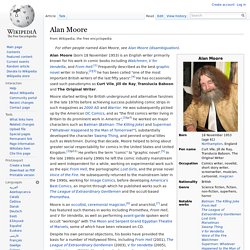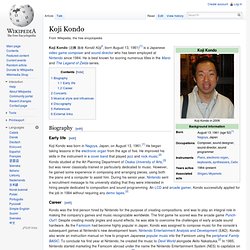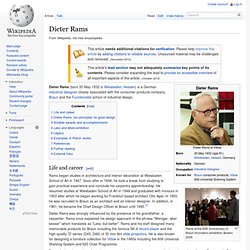

Alan Moore. Alan Moore (born 18 November 1953) is an English writer primarily known for his work in comic books including Watchmen, V for Vendetta, and From Hell.[1] Frequently described as the best graphic novel writer in history,[2][3] he has been called "one of the most important British writers of the last fifty years".[4] He has occasionally used such pseudonyms as Curt Vile, Jill de Ray, Translucia Baboon and The Original Writer.

Moore is an occultist, ceremonial magician,[6] and anarchist,[7] and has featured such themes in works including Promethea, From Hell, and V for Vendetta, as well as performing avant-garde spoken word occult "workings" with The Moon and Serpent Grand Egyptian Theatre of Marvels, some of which have been released on CD. Early life[edit] "LSD was an incredible experience. Not that I'm recommending it for anybody else; but for me it kind of – it hammered home to me that reality was not a fixed thing. Alan Moore (2003)[2](pp19–20) Gustave Doré. Paul Gustave Louis Christophe Doré (/dɔːˈreɪ/; French: [ɡystav dɔʁe]; 6 January 1832 – 23 January 1883) was a French artist, printmaker, illustrator and sculptor.

Doré worked primarily with wood engraving. Biography[edit] «Le Christ quittant le prétoire» Doré was born in Strasbourg on 6 January 1832. By age five, he was a prodigy troublemaker, playing pranks that were mature beyond his years. Les Oceanides Les Naiades de la mer, 1860s In 1853, Doré was asked to illustrate the works of Lord Byron.[2] This commission was followed by additional work for British publishers, including a new illustrated English Bible.
In the 1860s he illustrated a French edition of Cervantes's Don Quixote, and his depictions of the knight and his squire, Sancho Panza, have become so famous that they have influenced subsequent readers, artists, and stage and film directors' ideas of the physical "look" of the two characters. Koji Kondo. Biography[edit] Early life[edit] Career[edit] Kondo at the Game Developers Conference 2007 Concerts[edit] Kondo attended the world-premiere of Play!

Edward Gorey. Edward St.

John Gorey (February 22, 1925 – April 15, 2000) was an American writer and artist noted for his illustrated books.[1] His characteristic pen-and-ink drawings often depict vaguely unsettling narrative scenes in Victorian and Edwardian settings. Early life[edit] In the early 1950s, Gorey, with a group of recent Harvard alumni including Alison Lurie (1947), John Ashbery (1949), Donald Hall (1951), and Frank O'Hara, amongst others, founded the Poets' Theatre in Cambridge, which was supported by Harvard faculty members John Ciardi and Thornton Wilder.[3][4][5] He frequently stated that his formal art training was "negligible"; Gorey studied art for one semester at the School of the Art Institute of Chicago in 1943.
Career[edit] His first independent work, The Unstrung Harp, was published in 1953. The New York Times credits bookstore owner Andreas Brown and his store, the Gotham Book Mart, with launching Gorey's career: "it became the central clearing house for Mr. Dieter Rams. Rams at the 50th Anniversary of Braun Innovation exhibition, Boston 2005 Life and career[edit] Rams began studies in architecture and interior decoration at Wiesbaden School of Art in 1947.

Soon after in 1948, he took a break from studying to gain practical experience and conclude his carpentry apprenticeship. He resumed studies at Wiesbaden School of Art in 1948 and graduated with honours in 1953 after which he began working for Frankfurt based architect Otto Apel. In 1955, he was recruited to Braun as an architect and an interior designer. Dieter Rams was strongly influenced by the presence of his grandfather, a carpenter. By producing electronic gadgets that were remarkable in their austere aesthetic and user friendliness, Rams made Braun a household name in the 1950s.
In 2010, to mark his contribution to the world of design, he was awarded the 'Kölner Klopfer' prize by the students of the Cologne International School of Design. Dieter Rams: ten principles for good design[edit]